Introduction:
In the realm of education, technology continues to revolutionize the way students learn and teachers teach. Among the myriad of educational tools available, Windows tablets stand out for their versatility, portability, and functionality. This article explores how Windows tablets are enhancing learning experiences in educational settings.
Mobility and Accessibility:
Windows tablets offer students and educators the freedom to learn and teach from anywhere, whether it's in the classroom, library, or even outdoors. Their lightweight design and compact size make them easy to carry, allowing for seamless integration into various learning environments. With instant access to educational resources and apps, students can engage in learning activities beyond the confines of traditional classrooms.
Interactive Learning:
One of the key advantages of Windows tablets is their interactive capabilities, which foster active participation and engagement among students. Touchscreen functionality enables intuitive interaction with educational content, making learning more immersive and enjoyable. Whether it's exploring interactive simulations, solving puzzles, or collaborating on projects, students can actively participate in their learning journey, thereby enhancing comprehension and retention.
Personalized Learning:
Windows tablets empower educators to tailor instruction to meet the diverse needs and learning styles of individual students. Through the use of educational apps and digital resources, teachers can provide personalized learning experiences that cater to each student's strengths, interests, and learning pace. Adaptive learning platforms on Windows tablets analyze student performance data to deliver targeted interventions and personalized feedback, ensuring that every student receives the support they need to succeed.
Collaborative Learning:
Collaboration lies at the heart of effective learning, and Windows tablets facilitate seamless collaboration among students and educators. With features such as cloud storage, real-time document sharing, and collaborative whiteboarding apps, students can collaborate on projects, share ideas, and engage in group discussions regardless of their physical location. This fosters a sense of teamwork, communication skills, and collective problem-solving abilities among students, preparing them for success in the digital age.
Multimedia Learning:
Windows tablets offer multimedia-rich learning experiences that cater to diverse learning modalities. Whether it's watching educational videos, listening to podcasts, or exploring interactive multimedia content, students can engage with course material in ways that suit their preferences and learning styles. Furthermore, the integration of digital ink and stylus support on Windows tablets enables students to annotate, draw, and create multimedia content, fostering creativity and self-expression.
Conclusion:
As technology continues to reshape the landscape of education, Windows tablets emerge as powerful tools for enhancing learning experiences. From mobility and accessibility to interactive and personalized learning, Windows tablets offer a myriad of benefits that enrich the educational journey for both students and educators. By leveraging the capabilities of Windows tablets, educational institutions can create dynamic learning environments that inspire curiosity, foster collaboration, and prepare students for success in the digital era.





Comments